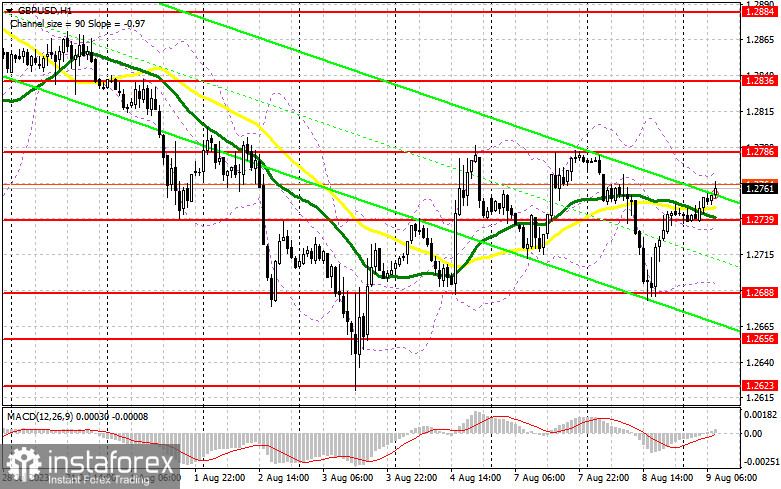Yesterday, the pound/dollar pair formed several entry signals. Let's discuss what happened on the 5-minute chart. In my morning review, I mentioned the level of 1.2739 as a possible entry point. A decline to this level and its false breakout formed entry signals for buying the pound which resulted in a rise of 10 pips. The price failed to develop a stronger upside movement, and bears broke below 1.2739 on the second attempt. In the second half of the day, a breakout of 1.2707 and its retest generated a sell signal, sending the price down by 20 pips.

For long positions on GBP/USD:
Statements by US politicians combined with weak US data limited the pair's downside potential on Tuesday afternoon. Amid the lack of economic reports today, bulls will have a chance to retest this week's highs. But before this, they need to protect the immediate support at 1.2739 that was formed yesterday. A false breakout of this level could form a good entry point for long positions, which may lead to a surge towards the resistance zone of 1.2786, the high of this week. A breakout and consolidation above this range could set the stage for a bullish market, with the next target at 1.2836. The ultimate target might be the resistance at 1.2884 where I will be taking profits. If there is a decline to 1.2739 without any buying interest, the pair will likely continue to trade sideways. In such a scenario, only the defense of the 1.2688 area and its false breakout would give a signal for opening long positions. I plan to buy GBP/USD right on a rebound from the 1.2656 low, keeping in mind a daily correction of 30-35 pips.
For short positions on GBP/USD:
As for bears, they also have ample opportunities today. Their strategy should be to defend the 1.2786 level and reclaim control over 1.2739 where moving averages currently favor the bulls. A failure to settle above the week's high of 1.2786 in the morning session will generate a sell signal with a prospect of returning to the 1.2739 zone. A breakout of this level and its upward retest would significantly dent the buyers' positions, offering a chance for a more substantial decline towards 1.2688. The ultimate target for this downtrend would be the 1.2656 low, where I would recommend taking profits. If GBP/USD rises and bears are idle at 1.2786, bulls will regain full control of the pair and may start an upward correction towards 1.2836. Only a false breakout at this level would provide an entry point for going short. If there is no downward movement there, I would sell the pound right on a rebound from 1.2884, hoping for an intraday correction of 30-35 pips.

COT report:
The Commitments of Traders (COT) report for August 1st recorded a decline in both long and short positions. Traders have been closing their positions in anticipation of a crucial meeting of the Bank of England. Interestingly, despite recent decisions by the US Federal Reserve and the European Central Bank, the Bank of England signaled its intention to maintain an aggressive stance in an attempt to combat rising inflation. Notably, the recent COT report does not take into account the changes after the regulator's meeting. Therefore, we can downplay the results of this report. Looking ahead, markets anticipate an important GDP report from the UK which the Bank of England relies on when making decisions. However, the optimal strategy remains to buy the pound on dips. The divergent policies of central banks will continue to influence the prospects of the US dollar, asserting downward pressure on it. The latest COT report indicates that long positions of the non-commercial group of traders have decreased by 13,323 to 92,175, while short positions dipped by 3,890 to 42,613. Consequently, the spread between long and short positions narrowed by 1,308. The weekly closing price dropped to 1.2775 compared to the prior value of 1.2837.

Indicator signals:
Moving Averages
Trading around the 30- and 50-day moving averages indicates a sideways nature of the market..
Please note that the time period and levels of the moving averages are analyzed only for the H1 chart, which differs from the general definition of the classic daily moving averages on the D1 chart.
Bollinger Bands
In case of a decline, the lower band of the indicator at 1.2700 will act as support.
Description of indicators:
• A moving average of a 50-day period determines the current trend by smoothing volatility and noise; marked in yellow on the chart;
• A moving average of a 30-day period determines the current trend by smoothing volatility and noise; marked in green on the chart;
• MACD Indicator (Moving Average Convergence/Divergence) Fast EMA with a 12-day period; Slow EMA with a 26-day period. SMA with a 9-day period;
• Bollinger Bands: 20-day period;
• Non-commercial traders are speculators such as individual traders, hedge funds, and large institutions who use the futures market for speculative purposes and meet certain requirements;
• Long non-commercial positions represent the total number of long positions opened by non-commercial traders;
• Short non-commercial positions represent the total number of short positions opened by non-commercial traders;
• The non-commercial net position is the difference between short and long positions of non-commercial traders.





















